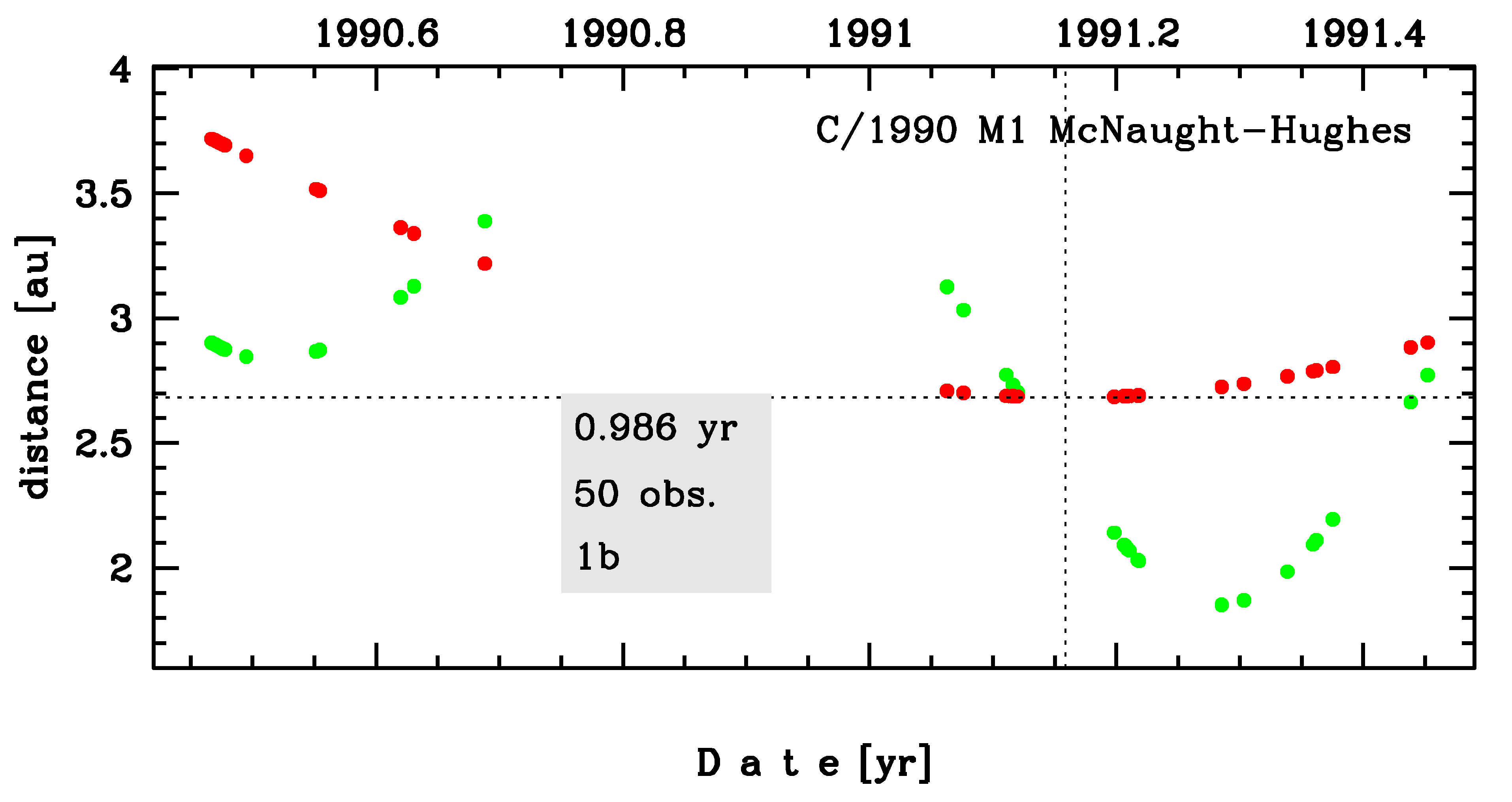C/1990 M1 McNaught-Hughes
more info
In IAU Circ. No 5036, Robert H. McNaught reported his discovery of a comet on a U.K. Schmidt Telescope R plate taken by Shaun M. Hughes on 19 June at Siding Spring.At the moment of discovery, this comet was about 8.5 months before its perihelion passage.This comet was last observed in mid-June 1991.
Comet had its closest approach to the Earth on 13 April 1991 (1.853 au), about 1.5 month after perihelion passage.
Solution given here is based on data spanning over 0.986 yr in a range of heliocentric distances: 3.72 au – 2.68 au (perihelion) – 2.90 au.
This Oort spike comet suffers small planetary perturbations during its passage through the planetary system; however, these perturbations lead to escape the comet on hyperbolic orbit from the planetary zone.
See also Królikowska 2020.
Comet had its closest approach to the Earth on 13 April 1991 (1.853 au), about 1.5 month after perihelion passage.
Solution given here is based on data spanning over 0.986 yr in a range of heliocentric distances: 3.72 au – 2.68 au (perihelion) – 2.90 au.
This Oort spike comet suffers small planetary perturbations during its passage through the planetary system; however, these perturbations lead to escape the comet on hyperbolic orbit from the planetary zone.
See also Królikowska 2020.
| solution description | ||
|---|---|---|
| number of observations | 50 | |
| data interval | 1990 06 19 – 1991 06 14 | |
| data type | perihelion within the observation arc (FULL) | |
| data arc selection | entire data set (STD) | |
| range of heliocentric distances | 3.72 au – 2.68 au (perihelion) – 2.9 au | |
| detectability of NG effects in the comet's motion | NG effects not determinable | |
| type of model of motion | GR - gravitational orbit | |
| data weighting | NO | |
| number of residuals | 95 | |
| RMS [arcseconds] | 0.87 | |
| orbit quality class | 1b | |
| previous orbit statistics, both Galactic and stellar perturbations were taken into account | ||
|---|---|---|
| no. of returning VCs in the swarm | 4995 | * |
| no. of escaping VCs in the swarm | 6 | |
| no. of hyperbolas among escaping VCs in the swarm | 0 | |
| previous reciprocal semi-major axis [10-6 au-1] | 24.42 – 30.07 – 35.15 | R |
| previous perihelion distance [au] | 510 – 800 – 1300 | R |
| previous aphelion distance [103 au] | 56 – 66 – 81 | R |
| time interval to previous perihelion [Myr] | 4.2 – 5.5 – 7.8 | R |
| percentage of VCs with qprev > 20 | 100 | |
| previous_g orbit statistics, here only the Galactic tide has been included | ||
|---|---|---|
| no. of returning VCs in the swarm | 4960 | * |
| no. of escaping VCs in the swarm | 41 | |
| no. of hyperbolas among escaping VCs in the swarm | 0 | |
| previous reciprocal semi-major axis [10-6 au-1] | 22.37 – 29.47 – 36.81 | R |
| previous perihelion distance [au] | 21 – 63 – 290 | R |
| previous aphelion distance [103 au] | 54 – 68 – 89 | R |
| time interval to previous perihelion [Myr] | 4.4 – 6.1 – 9 | R |
| percentage of VCs with qprev < 10 | 1 | |
| percentage of VCs with 10 < qprev < 20 | 8 | |
| percentage of VCs with qprev > 20 | 91 | |
